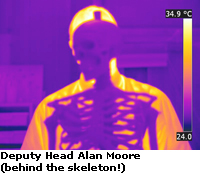Kent students see the invisible thanks to a FLIR donation
16/08/2010
 A practical introduction to thermal imaging at Rainham Mark Grammar School in Kent started calmly enough with the presenter, FLIR Systems’ Kevin Saxton, asking students to put a hand imprint on their shoulder. The thermographic camera trained on the scene revealed thermal traces of where hands had been via a projected image on the science lab wall. Respectful silence soon gave way to enthusiastic giggles.
A practical introduction to thermal imaging at Rainham Mark Grammar School in Kent started calmly enough with the presenter, FLIR Systems’ Kevin Saxton, asking students to put a hand imprint on their shoulder. The thermographic camera trained on the scene revealed thermal traces of where hands had been via a projected image on the science lab wall. Respectful silence soon gave way to enthusiastic giggles.The students were hooked. The technology that they had regularly seen on TV programmes, such as Police Camera Action and Springwatch, was in their classroom. And it wasn’t long before Bunsen burners, ice cubes and lollies were being used as props to put the camera through its paces. This highly visual technology was already making its mark on a new generation of potential scientists and engineers.
The presentation preceded the formal hand-over of a FLIR thermal imaging camera to the school’s Head, Simon Decker, on Thursday 8 July 2010. FLIR Systems, based in West Malling, Kent, is the UK sales and service arm of the world-leading manufacturer of thermal imaging cameras.
The company has donated one of its compact FLIR i-Series cameras to Rainham Mark Grammar to enhance curriculum provision. Although it was delightful to see students being entertained by the technology, the serious purpose of the gift is for them to explore its practical application across a range of disciplines.
Rainham Mark Grammar School is bucking the trend in science subjects with regularly more than half its sixth form students taking an ‘A’ Level science. “Out of more than thirty possible subjects, the sciences are always in our top six,” explained physics teacher and Deputy Head, Alan Moore. “And many of our students go on to pursue careers in medicine and the pure sciences.”
With such a good track record, the school is naturally keen to underpin this success with any additional facility that can help its teachers enthuse more would-be scientists. Alan Moore continued: “We are always on the look-out for opportunities to enhance our teaching practice.” And the FLIR Systems thermal imaging will certainly be serving this purpose with immediate effect.
The first project with which it will be involved is a week-long science residential course later in July. Science teacher Emma Laxton will take a group of thirty-three Year 7 pupils to the Gibraltar Point Nature Reserve near Skegness. “They will be able to use the infrared technology first hand to record images of nocturnal animals such as bats and owls,” she explained. “We will also be looking at surface water temperature and other objects, both living and inert.”
Another prospective project for the camera is assisting a student working party that has been charged with the task of examining the sustainability of the school. So in this regard the FLIR camera will be used to discover failings in building fabric and locate the sources of energy loss.
Emma Laxton concluded: “This infrared camera donation will allow our students at every key stage to use this technology. It will find applications across all the sciences on a day-to-day basis and we are very grateful to FLIR Systems for its interest and generosity.”